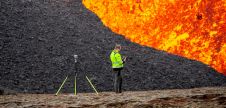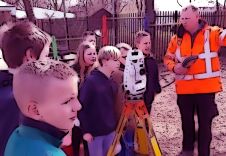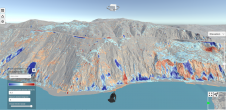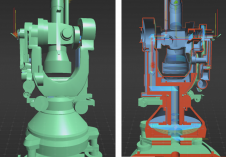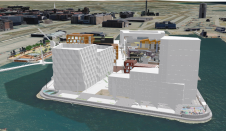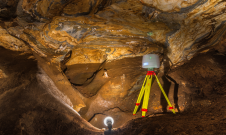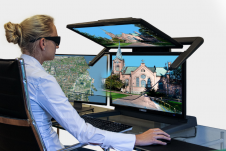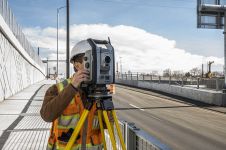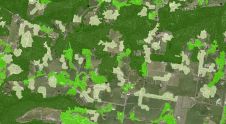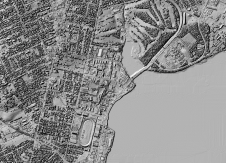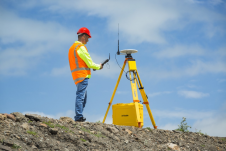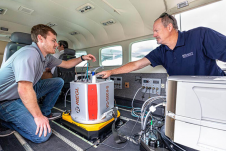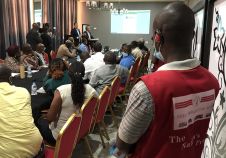通过与遥感数据进行融合来扫描陆地激光扫描
在森林生态系统中探索跨空间尺度的3D信息
Terrestrial laser scanning is increasingly being fused with air/spaceborne Lidar to characterize vegetation structure across a range of forest ecosystems. This article explores the potential of this approach to support scaling up for larger areas in practice.
陆地激光扫描(TLS)是树木和森林结构的绘图尺度测量的重要工具。这些局部测量对于支持森林平衡和长期森林监测的定量有意义。通常,通过将TLS数据与机载和Spaceborne Lidar耦合,可以促进从单个树木到本地地块测量到区域或国家估计的升级。最近,TLS数据与空气/太空传播激光雷达的融合增加了,以表征各种森林生态系统的植被结构。
TLS data can already provide accurate estimations of tree volume and biomass. This is crucial to monitor carbon changes as a result of climate change, as well as for forestry and forest management. Moreover, the rich 3D datasets that TLS can provide are becoming ever-more widely used in environmental science in general, and ecology in particular. Specifically, there are many open and important science questions regarding the relationship between tree form and function that 3D information is helping to unpick. In addition, a range of other areas relating to biodiversity, habitats and movement of birds, insects and small mammals are also a function of forest structure. Next, branch architecture traits could further be related to leaf and wood properties at the whole tree level. Unfortunately, the upscaling to larger areas in practice is limited to the amount of resources that can be allocated to the collection of TLS data over larger areas (>10ha). In this context, the potential of other laser scanning platforms (spaceborne, airborne, unmanned aerial vehicles) is interesting in the context of fusion with TLS data.
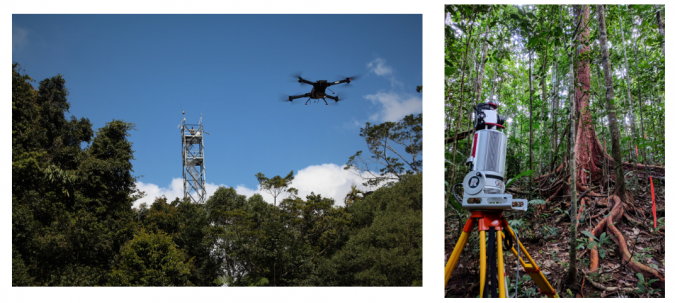
通常,数据融合可以通过两种不同的方式看待。一方面(类型1),融合可以将两个单独的数据集的组合参考到一个独特的新数据集中。在这种情况下,所得(融合)数据集建立在每个传感器的强度上,并更完整地查看采样对象。两个具有不同观点的数据集被共同注册并组合成一个点云,以减少两个单独的点云中存在的遮挡。当两个单独的数据集代表相同级别的空间细节时,这种类型的融合通常很有趣。另一方面(类型2),可以将单独的数据集在空间对齐(共同注册),但不能转换为单个唯一数据集。通常,当单个数据集具有非常不同的细节级别时,通常情况就是这种情况。但是,由于互补的空间范围,这种类型的融合不仅有趣地研究了随着时间的推移结构的变化,而且在校准和验证太空遥感产品的背景下也至关重要。
陆生和无人机激光融合
To cover larger areas while maintaining a comparable level of detail compared to TLS, unmanned aerial vehicles (UAVs) equipped with laser scanners (UAV-LS) are being explored as a possible solution to speed up the scanning process over larger areas (>1-100ha). Currently there are multiple commercial UAV systems available, with a large variation in data quality. Recent UAV-LS systems have produced point clouds with point densities ranging from 50 to >4,000 points per square metre. UAV-LS demonstrates significantly higher point density at lower cost and with higher flexibility, but with significantly smaller spatial coverage when compared to traditional airborne laser scanning (ALS).
TLS和UAV-LS融合到单个熔融数据集中特别有趣,因为这两种技术捕获了森林的不同部分(图1)。由于其上方的视图,UAV-LS可以解释在TLS中被遮挡的冠层部分,并改善在图和树级上得出的结构指标。因此,优选高密度的无人机数据,尤其是对于密集且结构上复杂的热带森林。当存在关键数量的常见空间特征以充当领带时,可以实现UAV-LS和TLS点云的良好空间比对(图2和3)。
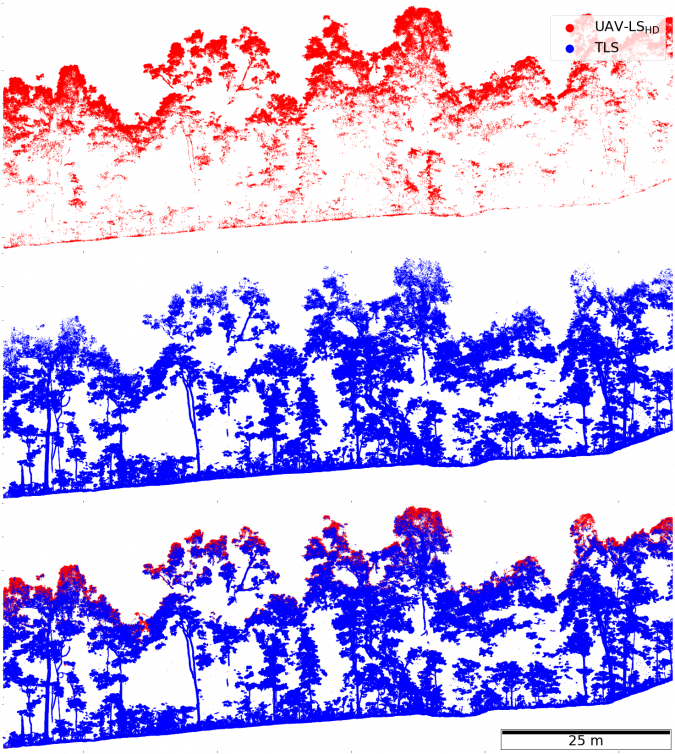
融合点云不仅可用于改善结构指标,而且还可以参考研究独立TLS和UAV-LS的潜在和极限。此外,融合点云可以用作局部校准工具,以改善景观尺度上的独立无人机结构估计。
Terrestrial and airborne Lidar fusion
As outlined above, a key challenge in making the best use of these new sources of 3D information lies in combining them in such a way as to bring the best, most useful information of each source together into a single dataset. The major advances in measurements of individual tree structure from TLS and UAV-LS are in part limited by scale. ALS is embedded in forestry management and practice, as well as in environmental science, in part because it can cover large areas rapidly.
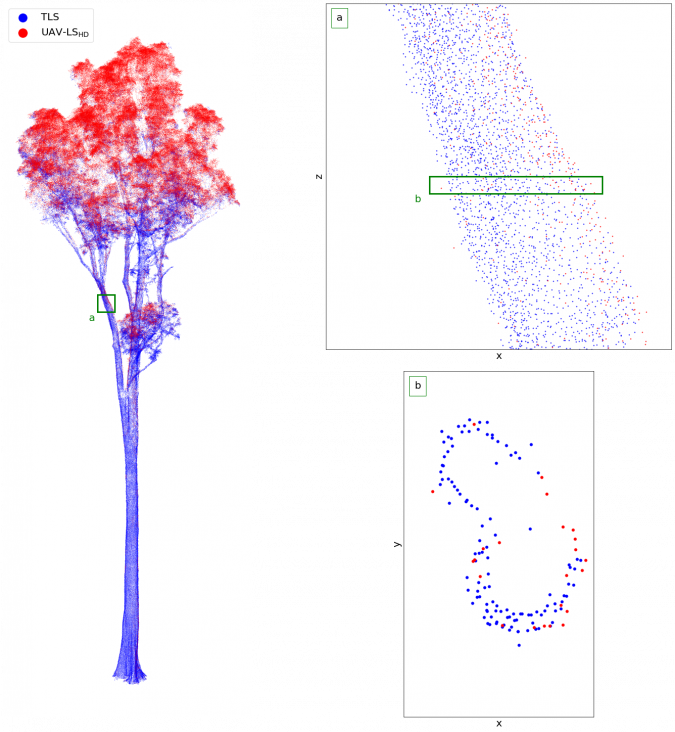
ALS的遗产相对较长,这意味着有广泛的已建立工具和工作流程用于提取树和森林信息,目前比TLS和UAV-LS更重要。ALS通常提供冠层高度,茎密度和潜在垂直结构的估计。不用说,权衡是细节:ALS提供的每平方米不到100点,而UAV-LS的可能数千(以及来自TLS的更多),通常具有较低的冠层渗透和较大的占地面积(图4)。但是ALS是并且将仍然是一个重要的桥接工具,尤其是将情节尺度测量与太空传播的工具联系起来。ALS支持了许多本地,地区和国家的冠层覆盖范围(尤其是在城市环境中),碳库存,增长和产量以及栖息地类型,森林变化地图等。结果,有一个非常重要的时间序列ALS在某些地方可以追溯到几十年。
将ALS与TLS相结合的许多开发都集中在如何将这些更汇总的ALS衍生的冠层特性与TLS的树尺度细节联系起来。共同注册TLS和ALS点云的挑战甚至比TLS对无人机LS的挑战更大,这主要是由于覆盖范围更大的面积。尽管平台位置和态度的技术改进肯定会有所帮助,但集成的下一步可能是算法,即类似于猛烈的方法,但根据数据集本身,在较大的尺度上进行了算法。从大区域的覆盖范围(包括通过机器学习/深度学习)来识别和描述单个树冠方面已经有了重大发展。将其与TLS的信息相结合,已经允许在单个树尺度上改善匹配,尤其是在较少密集的森林区域。
另一种方法是采用另一种方式,将其从TLS到ALS(可能通过UAV-LS)的高度和植被密度估计值估计。这具有不需要在树尺度上共同注册的优点,因此一种非常有吸引力的务实方法。缺点是详细的树级信息的丢失。广泛认识到地面和空降数据之间建立联系的重要性。新的地球观察卫星委员会(CEO)活动使这一明确针对与地面生物量和碳库存有关的应用。例如,地质树计划旨在建立全球一百个或多个永久1公顷生物量参考地点的网络,迫切需要这些网络,以改善卫星和空中森林碳的估计值的校准和验证。

机载和太空传子融合
提供有关森林/冠层结构信息的Spaceborne LiDAR数据集限于三个不同的任务:ICESAT-1(2003-2009),ICESAT-2和全球生态系统动力学调查(GEDI)。顾名思义,ICESAT 1和2主要设计用于测量冰盖的生长和收缩,并且只专门设计用于映射冠层结构。GEDI于2018年末推出,目前正在国际空间站的有利位置绕地球绕地球。GEDI collects full-waveform Lidar data, so instead of the detailed point clouds resulting from TLS measurements, the instrument collects a ‘waveform’ containing information on ground elevation, canopy height and vertical canopy structure at each sampling location, whereby the sampling location spans an approx. 25m-diameter circle. Given the vantage point from space, the sampling pattern is much less dense than from airborne Lidar data, but the advantage of GEDI is that it collects consistent Lidar measurements across nearly all temperate and tropical forests (between roughly 51.6 degrees North and South latitude).
exc涉及星载激光雷达数据的数据融合lusively of the second type mentioned above; two datasets are spatially aligned (co-registered) but not converted into a single unique dataset. High-resolution airborne Lidar datasets, spatially aligned with spaceborne data, can be used to validate the spaceborne measurements of canopy height and the vertical profile (Figure 5). Spaceborne and airborne fusion can also be used to assess changes in canopy structure over time, for example, using the time lag between data collection. Differences in canopy structure as measured by the two instruments can potentially be attributed to natural and human-induced processes. Additionally, airborne reference datasets can be used to train models to extract more information from the spaceborne Lidar datasets than is currently possible. Going even further, spaceborne and airborne Lidar datasets could even be fused with other spaceborne remote sensing data products at high resolution to train advanced machine learning models to estimate canopy structure over vast areas at higher resolution than is possible with spaceborne Lidar data alone.
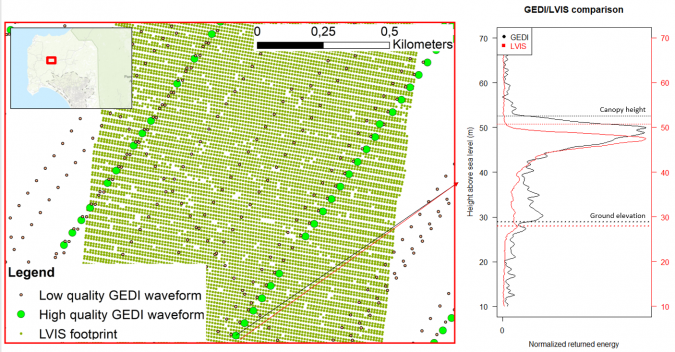
Conclusion
3D information on the Earth’s forest ecosystems is essential to support long-term carbon monitoring, especially now that the world’s climate is under increased pressure. TLS data can already provide accurate estimations of tree volume and biomass, but in practice the spatial coverage is limited to just a few hectares. Larger areas can be mapped with UAV, airborne and spaceborne Lidar and this article has described how such data can be fused with TLS in two different ways to support upscaling.
Further reading
Calders,Kim等。森林生态学中的陆地激光扫描:扩展地平线。环境遥感251(2020):112102。





